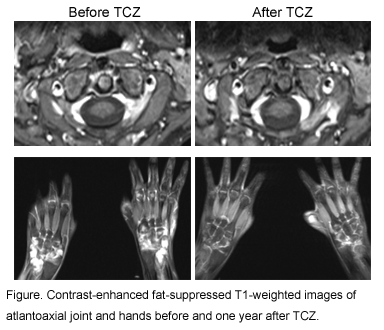Session Information
Session Type: Abstract Submissions (ACR)
Background/Purpose: Magnetic Resonance Imaging (MRI) has been established as a useful modality to evaluate synovitis, bone edema, and bone erosion in patients with rheumatoid arthritis (RA). Most of previous MRI studies in RA, however, have focused their evaluation only on finger, wrist, or knee joints. In daily clinical practice for RA, we use whole-body MRI technique to validate effect of anti-rheumatic drugs. The purpose of this study was to clarify the efficacy of tocilizumab (TCZ) in patients with RA using this technique.
Methods: A total of 21 consecutive RA patients on TCZ in our department between 2008 and 2014 were included in this retrospective study. Contrast whole-body MRI (1.5T) was performed before and one year after the initiation of TCZ. MR images were assessed by one experienced radiologist without any clinical information. Hand joints were evaluated according to RA MRI score (RAMRIS) and the other joints (atlantoaxial, shoulder, hip, and knee joints) were scored in the modified RAMRIS for this study.
Results: Mean age was 54.7 years old and mean duration of the disease 2.7 years. Of the subjects, 67% were on methotrexate and 24% had a history of other biologics agents. Mean DAS28-ESR at baseline was 5.04. After one year, clinical remission was obtained in 76%, 57% and 57% by DAS28-ESR, CDAI and SDAI, respectively. TCZ treatment led to improvement (Figure) in whole-body synovitis score (p < 0.01, paired t-test) from baseline (mean ± S.D; 32.6 ± 15.2) to one year (22.2 ± 11.0), as well as in whole-body bone edema score (p < 0.01, Wilcoxon signed-rank test) from baseline (median [range]; 11 [1-45]) to one year (3 [0-15]). Whole-body MRI-bone-erosion-score was improved in six patients and deteriorated in 11 patients. Whole-body synovitis score (p = 0.03, t-test) was identified as one of the poor prognostic factors for development of whole-body MRI-bone-erosion. Changes in RAMRIS synovitis score of hands did not correlate with those in modified RAMRIS synovitis score of other joints in whole-body MRI (r = 0.34, p = 0.13), as in the cases of bone edema score (r = 0.01, p = 0.96) and of MRI-bone-erosion-score (r = -0.13, p = 0.57).
Conclusion: TCZ exhibited significant efficacy and improvement in synovitis and bone edema. Changes in synovitis, bone edema, or erosion detected by hand MRI did not correlate with those of other joints in whole-body MRI. Whole-body MRI may be a potent tool to evaluate the inflammation and structural damage of the joints in RA independent of traditional hand MRI.
Disclosure:
M. Kono,
None;
S. Yasuda,
None;
K. Ohmura,
None;
T. Fukui,
None;
S. Shimamura,
None;
I. Nakagawa,
None;
A. Noguchi,
None;
H. Shida,
None;
T. Watanabe,
None;
Y. Shimizu,
None;
T. Kurita,
None;
K. Oku,
None;
T. Bohgaki,
None;
O. Amengual,
None;
T. Horita,
None;
K. Sakamoto,
None;
T. Kamishima,
None;
T. Atsumi,
Chugai Pharm inc.,
9.
« Back to 2014 ACR/ARHP Annual Meeting
ACR Meeting Abstracts - https://acrabstracts.org/abstract/efficacy-of-tocilizumab-in-patients-with-rheumatoid-arthritis-sequential-evaluation-using-whole-body-magnetic-resonance-imaging/

